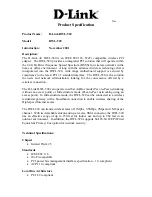
OPTIMOD-PC INTRODUCTION
1-21
To connect to a card you must first add the host computer/server to your control ap-
plication via
C
ONNECT
:
A
DD
P
ROFILE
/C
ARDS
(step 10 on page 2-11). Here, you provide
the host computer’s IP address and port number. Once a profile/card is added, you
can connect to it by double-clicking on the card in the
C
ONNECT
drop-down list.
Each local copy of the Orban Control application allows you to name a server (e.g.,
“Boston”) so you do not have to remember its IP address and port number each
time you connect the Control application to it.
The server names are stored locally on each computer; each local copy of
the Orban Control application can create a different profile name for a
given server. A server’s real “name” is always its IP address and port.
You can see a drop-down list of all cards that have been added previously, regard-
less of whether you are logged onto the host computer housing those cards. Once
you have logged onto the host computer, you can connect to any card on this list if
it is “available” (that is, if it is still installed in the host computer; removing a card
from its host computer will not automatically remove its name from a client com-
puter). If you have not previously connected to a given card and specified “remem-
ber password,” you must supply your User password before you can connect.
Once you have specified “remember password,” the password dialog box
will not appear again and the “remember password” status can only be
canceled by an administrator. “Remember password” can compromise se-
curity, so you should use this feature with discretion.
Only one client can be logged into a given card at one time; the card will return “in
use” if another client attempts to log into the same card. However, more than one
client can be logged onto a given host computer at once, provided that each client is
logged onto a different card within that host.
Section 2 of this manual provides detailed, systematic instructions for setting up a
network of OPTIMOD-PC cards.
Location of OPTIMOD-PC for Netcasting
It is usually best to locate OPTIMOD-PC cards in the same machine that runs the en-
coding software, like Orban OPTICODEC-PC, Microsoft Windows Media Encoder or
Real Networks HELIX Producer. This is because the output of the encoder is at a
much lower data rate than the audio used to drive the OPTIMOD-PC input(s), so it is
less expensive to transport encoded audio than unencoded audio. In Windows in-
stallations, the encoder receives the processed output of OPTIMOD-PC through the
standard Windows’ WAVE signal handling mechanism. You control mixing and rout-
ing through the OPTIMOD-PC I/O Mixer application, which you call from the
Tool>I/O Mixer menu item in the OPTIMOD-PC Control application.
OPTIMOD-PC’s digital inputs accept stereo pairs of uncompressed PCM-format digi-
tal audio. OPTIMOD-PC’s AES3 digital inputs will not accept “bitstream” inputs en-
coded with formats like Dolby Digital® or DTS®. Inputs must be two-channel “PCM”
(Pulse-Code Modulation) format with sample rates from 32 to 96 kHz and 8 to 24 bit
Содержание OPTIMOD-PC 1100
Страница 1: ...Operating Manual OPTIMOD PC 1100 Digital Audio Processor on a PCI Sound Card Software Version 2 0...
Страница 4: ......
Страница 5: ...Operating Manual OPTIMOD PC 1100 Digital Audio Processor on a PCI Sound Card Software Version 2 0...
Страница 18: ......
Страница 54: ......
















































